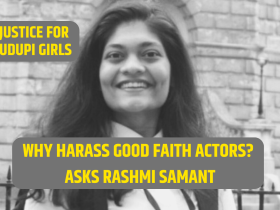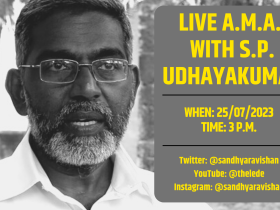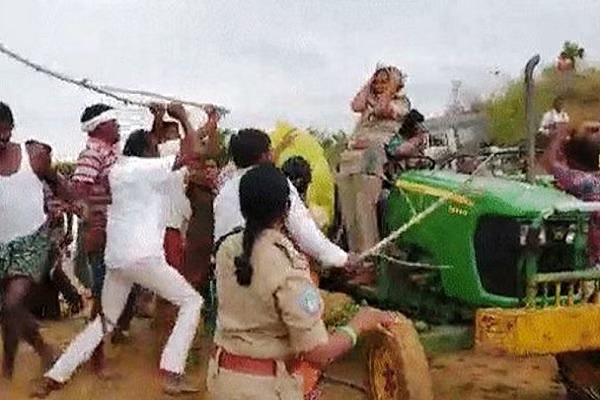There is a silent but ongoing state-sponsored attack on tribals and Dalits in Telangana.
In a three-part ground report, The Lede reveals how the lands of tribals and Dalits in Adilabad district are being indiscriminately snatched away by the Telangana government.
Worse, the state, in the form of its Forest Department, the police and local administration, is unleashing violence and harassment on poor tribals and Dalits who have cultivated their land for over three decades.
It does not seem to matter to the Telangana government that the tribals have land documents and some, even pattas, given to them by the government itself.
“Targets,” we were repeatedly told were more important than the livelihood and liberty of these tribals and Dalits.
Stories of extreme suppression of tribals and Dalits usually emerge only when these communities have been destroyed and broken beyond recognition.
But this is a story of repression and violence, of violation of basic human and land rights, unfolding in front of our very eyes. This is something that can be stopped before it grows bigger and more violent.
In India, there is no greater emotion than land. When this is taken away by force, especially from those with little else, anger brews. This is exactly what The Lede witnessed in all these areas.
And all of this for what? The chief minister’s “prestigious” Kaleshwaram irrigation project requires compensatory afforestation – cut down trees in one part of the state and plant them in another.
In the first part of this series, we tell you the untold story of Sarsala village and how truth has been twisted beyond recognition by those with the power to do so.
The Attack
It was a horrifying attack on an official, a woman at that, which took place on June 30.
C Anita, forest range officer in Kaghaznagar division, Adilabad was beaten with sticks on the head as she stood atop a tractor, arms outstretched, asking villagers to stop the violence.
Below is the video that went viral.
Anita later filed a complaint that Sirpur MLA Koneru Konappa’s brother Koneru Krishna had beaten her.
Along with Krishna, 37 villagers were arrested under IPC Sections 307 (attempt to murder), 147 (rioting), 148 (rioting with deadly weapon), 332 (voluntarily causing hurt to public servant), 353 (assault on public servant), 427 (mischief causing damage) read with Section 149 (unlawful assembly). Section 3 (2) (5) (a) of the Prevention of Atrocities against Scheduled Castes and Scheduled Tribes Act against 16 villagers of Sarsala.
On Independence Day, Forest range officer C Anita received an award from Telangana chief minister K Chandrasekhar Rao.
There is no doubt of course that Forest range officer C Anita was attacked. The video clearly shows that violence did take place.
But the popular version of the story is a post truth one.
The truth of Sarsala echoes across Adilabad district and extends to neighbouring districts as well.
Sarsala’s Truth
Burram Mallesh, 18, can barely hold back tears. He speaks as if he has a lump in his throat that he cannot get rid of.
He, along with his father and other villagers was jailed on June 30. It was only a week ago that he and 16 others were released on bail.
“My studies are finished,” he told The Lede. “We have lost everything – our land, our income. I am doing my second year in Inter College at Mancherial and I stay in a hostel there. Since I was in jail, I haven’t gone to college or hostel and so I have lost my room there too. Every Sunday I have to sign at the Easgaon police station, so I cannot go to college either,” he says.
“The others told me I cannot get a government job now that I have a case. My life is over,” he says.
Mallesh continually comes back to the question of justice. He wants to know why his family’s lands were taken away by the government without any notice or reason. He wants to know why his father Burram Pocham and other villagers were beaten so badly by the police at the Easgaon police station. He demands to know how he will pay his college fees now.
“Tell me, who will hear our voices? How is this fair? Everyone believes Anita madam’s version of the story. What about ours? We are speaking the truth but no one wants to listen,” he says and breaks down into uncontrollable sobs.
His mother Burram Vinoda, 45, belonging to the Backward Caste Yadava community, has no words to console him.
She is sick and in pain. Videos taken by the villagers, not released thus far, corroborate what Vinoda told The Lede.
“When Anita madam came with the tractor to clear our lands, we told her with folded hands – Amma, please don’t hit our stomachs. We fell at her feet. She kicked me with her boot heel.
Then a lot of people started hitting and dragging me around. The other villagers started shouting that I am being attacked and they came running. My husband – angry and not knowing whether I was alive or dead – he went and hit her,” she says.
Vinoda was pregnant at the time of the attack. Thanks to the beating she received, she lost the baby. Post abortion, her lands gone, her husband in jail, she is struggling to cope.
“I still have a lot of pain in my back. I am unable to do any work,” she says.
The Burrams cultivate five acres of land in Sarsala.
Naini Indra, 65, who cultivates three acres of land says that the forest officer attacked her too when she attempted to plead with her.
“When I fell at her feet, she kicked me on the forehead,” says Indra. “Then the others hit me on my chest. I could not get up for three days.”
Villagers who were present at the altercation state that the MLA’s brother Koneru Krishna did not in fact hit Forest range officer C Anita.
“Anita madam lied and the media turned that into truth,” says Bamini Nagesh, 22, who cultivates two acres in Sarsala. “If you watch the video closely, you will see what happened.
Krishna gaaru (respectful term in Telugu) was beating the tractor with a stick, demanding to know why the officers and police were trying to raze down our cultivated lands. When he lifted the stick up, Anita madam stretched out her arms.
“The stick accidentally hit her finger and she sustained a slight injury. It was Burram Pocham who actually beat her – this was because Anita madam had kicked his wife with her boot and the police had beaten up his son,” says Nagesh.
Other villagers who were witness to the incident, without exception, corroborated this sequence of events.
Koneru Krishna spoke to The Lede from hospital where he is currently lodged due to ill health. “I am not worried that I am in jail but it is important to do good by the tribals. I have been in public life here for more than 20 years and I have never lifted a hand against an officer.
I have always told farmers that they should never behave badly with officials. Pocham became angry because his wife was beaten badly. I am not worried, however much they attack me or harass me, I will stand up for my people,” he says.
But this was not the first attack on the villagers of Sarsala. On 08 June, Forest Department officials, along with forest ranger Anita arrived with three tractors at Sarsala.
Villagers claim that the forest officials harassed Lakkam Mallesh and when he realised that his land would be taken over, he consumed poison and lay down under a tree.
Subsequently villagers who found him, rushed him to hospital where he is recovering.
An Assault On Tribal Land Rights
Sarsala’s residents have lived here for over 30 years. Some have made it their home for four decades.
During the regime of YS Rajasekhar Reddy in united Andhra Pradesh, in 2006, Scheduled Tribes were enumerated and those who had been cultivating forest land under podu cultivation over generations, were given what are called ‘hakku pathram’ in Telugu.
These ‘hakku pathrams’ translating to document of rights, were, ironically enough, issued by the Forest Department itself at the time.
In June 2018, the KCR government issued ‘pattadhar passbooks’ to farmers ahead of providing financial benefits to small and marginal farmers.
A number of Sarsala’s residents are in possession of these passbooks as well.
The lands cultivated by Sarsala’s residents fall under Survey Number 193.
These lands, according to a letter from the Tahsildar of Kaghaznagar to the District Collector of Komaram Bheem Asifabad dated 05 July 2019 states clearly that “as per Pahani 2017-18 an area Acres 272.21 cents is assigned to 86 beneficiaries over Sy No 193, situated at Sarsala village of Kagaznagar mandal.”
Curiously, the same Tahsildar subsequently has given another version to the Sub Divisional Police Officer, Kaghaznagar in a letter on the same date.
In this letter, he states – “It is informed that as per Gazette published in Kadamba extent vide G.O. Ms No 916 Forest Department Dt. 15.07.1976, the Sy. No. PP extent 848 acres notified under reserve forest.”
Revenue land records reveal that Survey Number 193 comprises a total of 1850 acres of which 848 acres is indeed allocated as Reserved Forest. Another 272 acres has indeed been given to 86 beneficiaries.
But the real problem is over where boundaries of revenue land end and boundaries of forest land begin. Queries reveal that neither department has demarcated their boundaries, fenced them off or marked them with stones or other markers.
This lack of detail has allowed the Telangana Forest Department to unleash aggression over lands that are owned by tribals and other villagers claiming that the land belongs to the department.
Tribals in Sarsala showed The Lede their ‘hakku pathrams’ which allows them to cultivate on that portion of land.
Other communities like the BCs and Scheduled Castes own patta land here and have ‘pattadhar passbooks’ to show for it.
There are also a number who have not got either document but have been doing podu cultivation for decades.
Yet, the Forest Department and the police saw it fit to take over these lands by force, mow down the crop and go about planting neem, drumstick and other saplings in their afforestation mission.
Villagers say that they attempted to reason with the forest department officers by showing them their ‘hakku pathram’ but to no avail.
“I showed my ‘passbook’ but she (Anita) tore it into pieces saying her signature was not on it,” says Bibbera Shyamala, 35, who cultivates three acres of land in Sarsala. “She threw it on the ground and stepped on it.”
“She said KCR has given her permission,” recounts another villager Ambala Swaroopa, 21, who cultivates four acres here.
“She told us – you go and ask whoever gave you the ‘hakku pathram’. Anitha madam hit us, tore our ‘hakku pathrams’,” she says.
Lost Livelihood
The tribals and other families of Sarsala are now facing an uncertain future.
They grow cotton and after all expenses, are annually left with Rs 30,000 to Rs 40,000 per acre in a profitable year.
Last year though, the crop failed. Input costs for cultivating cotton comes to around Rs 50,000 which they take as a loan from the cooperative bank in Rasepally.
This year too they had taken a similar amount as loan from the bank. Now with their knee-high cotton crop destroyed by the Forest Department, a debt of Rs 1 lakh looms large, with no way to repay it.
“What will I do now?” asks Naini Indra. “I cannot do anything. I usually sell the cotton and repay the loans. Now there is no land, no agriculture. I don’t have cattle. They don’t allow us to use tractors,” she says in resignation.
Villagers speak of rampant corruption amongst Forest Department officials. “Every June we have to collect money and pay Rs 4000 to Rs 5000 per acre of land to the Forest Department officials,” says Bamini Nagesh.
“Otherwise they slap cases on us. They won’t allow us to collect firewood for our homes.”
Kotte Pullaya, 52, who cultivates three acres of land pipes up – “I once brought two bullock carts of firewood. The Forest officials made me pay Rs 10,000 per vehicle as bribe to allow it,” he recalls.
With the menfolk in jail and land occupied by the state, these villagers are surviving on the largesse of the Mannervalu Seva Samiti, a tribal rights non-profit.
Members of this NGO have been supplying Sarsala’s villagers with rice, pulses and vegetables to tide over the crisis until the rest of the jailed villagers are released.
“For two days, the police and the forest officers did not allow us near Sarsala,” says Merpalli Brahmaiah, Komaram Bheem district president of the NGO.
“We have been buying supplies from Kaghaznagar and sending it to them every month. When Anita madam hits our people, there is no action, despite us filing a complaint against her under the SC/ST Act.
But when our people hit her, they are thrown in jail. I am not condoning violence. But we need justice,” he says.
The Forest Officer’s Response
When The Lede met C Anita in her office at Kaghaznagar, she was polite and forthcoming with details of what had happened.
“We have been given targets in every district for compensatory afforestation for the Kaleshwaram project,” she begins. “We select degraded forest lands and do afforestation every year. 220 hectares were given for this division as the target for afforestation.
As per our head office, we were informed that we had to do afforestation in 40 hectares in Kaghaznagar, 20 hectares in Sarsala,” she says.
When queried about the villagers’ version of events, which state that Anita had initiated the violence, she told The Lede it was completely untrue.
“We have only taken over the forest land which has been illegally occupied and cultivated by the people. If you see in Sarsala, only 1-2 are tribals. All the others are BC – Golla.
Only 1-2 persons have had lands for over 10 years. In the past 3-4 years, these people have been slowly moving into and taking over forest land for cultivation. Every year they move a little more inwards.
We have not touched any patta lands or lands given under ‘hakku pathram’,” she says.
When asked about whether Koneru Krishna had in reality attacked her, Anita was evasive. “He hit me on my left hand,” she said.
“Pocham pushed women towards me. I did not abuse or hit anyone. If I said one thing that could be construed as arrogant it is this – I told them, if even one of you tries to touch me, see what happens. We are doing our duty, is what I told them.”
Anita continues – “I notified the district SP before going to Sarsala because of the earlier incident with the man consuming poison. There was a 20-30 strong force with armed police also there.
We started ploughing with three tractors and within ten minutes, women came to the spot. I was alone so I got onto the tractor. Koneru Krishna and others had sticks. I got hit on the head – I was dizzy and bleeding. It is Krishna who has encouraged them, the villagers are not so daring,” she says.
Anita claims the department has satellite images of when these settlements came into existence. “The images show who has been cultivating for 10 years, 5 years and 2 years and so on. We are only going by recent cases.”
When asked for the satellite images, Anita said only her superiors would be able to provide them.
“People say we are in poverty, allow us to cultivate,” says Anita. “But the forest is not to curb poverty. We cannot use forest land to curb poverty.”
But the mother of all ironies is the fact that the clash between farming tribals and the state is taking place in a district named Komaram Bheem.
Bheem was a farmer-leader during the Nizam’s time who led the unrest against the Nizam’s repression of farmers and the taking over of their lands.
He was ultimately found and killed by the Nizam’s men but continues to remain a legend in these parts of Telangana.
It now appears that the last Nizam’s position has now been taken over by the new Nizam of Telangana, KCR.









Leave a Reply